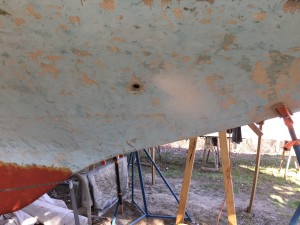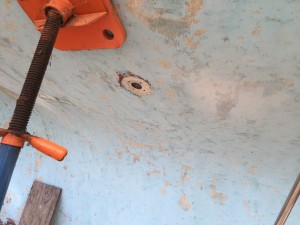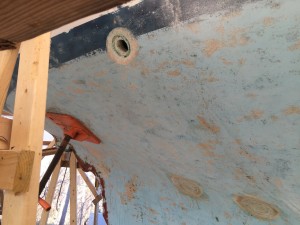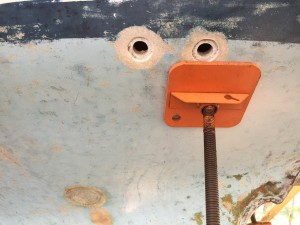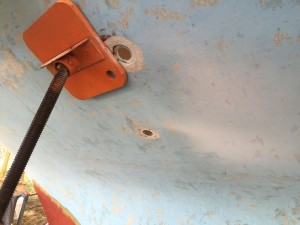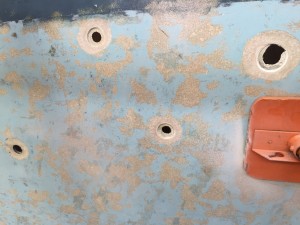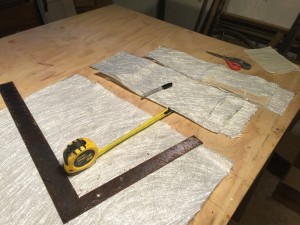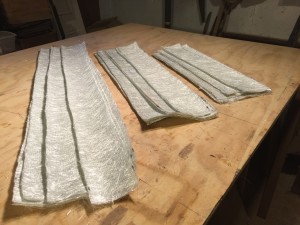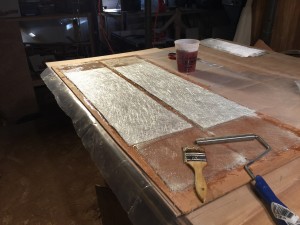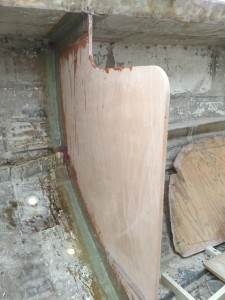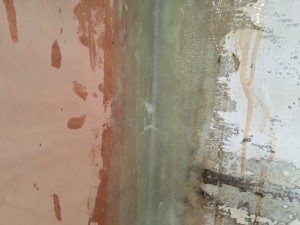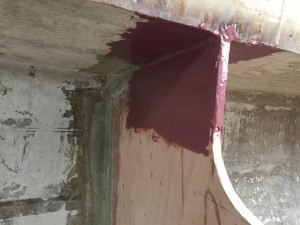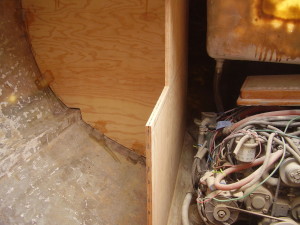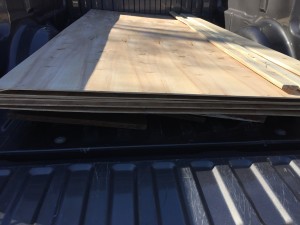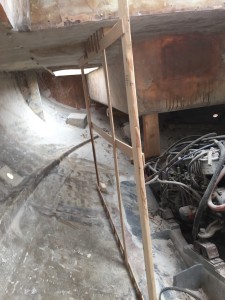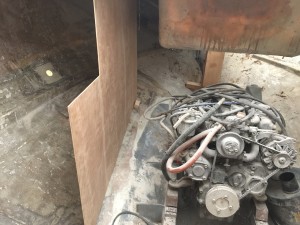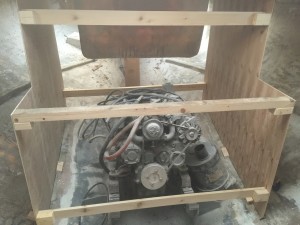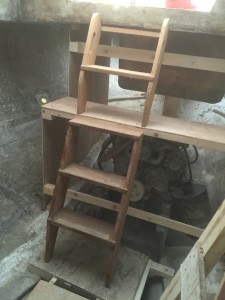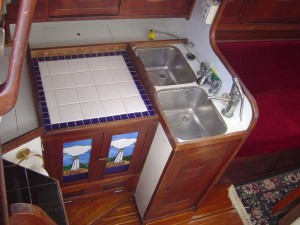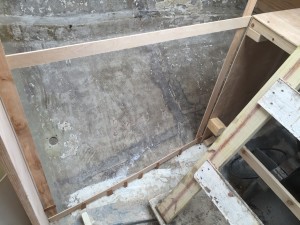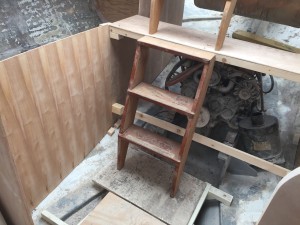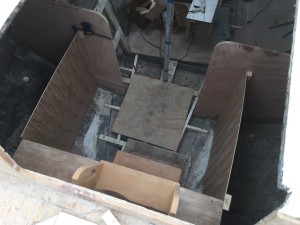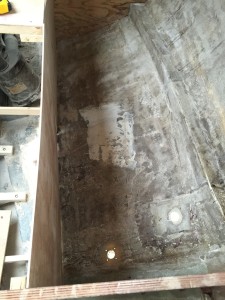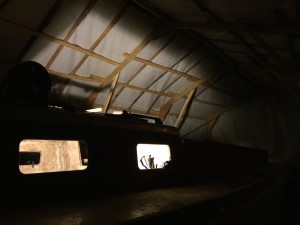4/26/16: Through Hulls, Bulkhead Tabbing, Galley
THROUGH HULLS
Thalassa has 18 holes through the fiberglass hull below the deck.
(1) Forward, starboard: Speedometer paddle
(2) Middle, starboard: Depth transducer
(3), (4), and (5): Aft, starboard: Deck drain (top), cockpit drain (lower left, partially glassed in) and raw water intake for engine (lower right, partially glassed in).
(6): Aft: Engine exhaust (not shown)
(7), (8), and (9): Aft, port: Deck drain (top left), bilge pump (top right), and cockpit drain (lower left, partially glassed in).
(10) and (11) Mid, port: Galley sink drain (top) and depth transducer (bottom).
(12): Holding tank vent (near deck, not shown)
(13), (14), (15) and (16): Forward port: Speedometer paddle (bottom left), head intake (lower right), head sink drain (upper left), and holding tank overboard (upper right).
(17) and (18): Forward, near deck: Running lights (not shown)
All of the holes pictured will be glassed in, and that work has begun. There is logic behind glassing them all in. First, some of them won’t be reused, so they must be glassed in anyway. Second, glassing in these holes in a relatively low-labor and low-materials job. Third, most of the existing holes aren’t in the precisely ideal location, so filling them all in will eliminate the temptation to reuse holes that aren’t quite where they should be. More on this later.
BULKHEAD TABBING
Meanwhile, work resumed on the bulkheads with preparation for tabbing, which consisted of three layers in 8-, 6-, and 4-inch widths. First the glass was cut, creating 36 strips of biaxial cloth in three lengths and three widths.
The glass was wet out in the workshop, then moved to the boat for application. This process is messy and labor-intensive, requiring lots of epoxy/resin, and lots of working out air bubbles with rollers, brushes, and gloved hands.
After the tabbing was all laid up, it was allowed to dry overnight, and the next two photos show the result.
The dried strips were washed with soap and water to remove the amine blush, then sanded. Thickened epoxy was spread over areas that won’t be covered by cabinetry. There is still plenty of filling and fairing to do on these bulkheads.
GALLEY AND ENGINE AREA
Back in 2010, bulkheads were constructed that flank the engine and separate the under-cockpit area with the main cabin. The following (old) photo shows those on the starboard side. These were designed to give a little more room around the engine, but now a lot more room around the engine is wanted. Moreover, the “marine” plywood used for these bulkheads turned out to be not-so-good (eventually it was found that 2″-wide strips of these 3/4″ sheets could be broken easily with bare hands.) Thus, new bulkheads will be constructed.
Seven sheets of cheap, 1/4-inch plywood were purchased to be sued to make patterns and mock-up templates.
A template was made for the starboard bulkhead that flanks the engine.
The pattern was transferred to the cheap plywood, resulting in a good template.
After making the port-side template, a significant amount of time was spent considering how to make these bulkheads exactly parallel to each other and also parallel to an imaginary vertical plane that runs fore and aft. Skipping over some of those details, the following photo shows part of the process, which utilized four equal-length board to which the templates were screwed. Notice the very generous spaces surrounding the engine. The original “engine room” was so cramped that engine access was extremely limited, and limited access discourages proper maintenance. Still, much of all this extra space will be eaten up by sound-proofing insulation, hoses, wires, fuel filters, water strainers, and etc.
Templates for the side bulkheads were simply made by trimming those installed back in 2010. Next, a mock-up engine-room shelf was made and the companionway ladders were checked for fit.
The mock-up process allows ideas to be tested without wasting expensive wood and other materials, not to mention valuable time. The following (very old) photo shows the original galley, which was all on the port side, and pushed way out toward the centerline, resulting in cramped cooking area, and long reaches to virtually inaccessible storage spaces along the hull and in the deep icebox. Note, for example, that the outboard sink is in a very awkward position and, thus, was rarely used as a sink.
What if the engine-flanking bulkheads are simply extended forward so that they meet the salon bulkheads perpendicularly? The following photo shows a pattern being constructed that was then used to make a mock-up template.
The next photo shows the template in place.
The corresponding port-side template was made and set up, and the next photo shows the view from the cockpit. This arrangement creates a very large cabin-sole area in the Galley, in which two people can comfortably move around each other, and one can easily step away from the companionway ladder to allow a crew-member to pass into the salon from the cockpit. The “lost” storage space that comes with this arrangement won’t be missed, as much of it was inaccessible anyway, and some of it has been regained under the cockpit anyway. (More on those details later.)
Here we are looking at the port-side spaces created between the hull and the mock-up bulkheads.
The plan now (which is subject to change) calls for the port-side galley to have a two-burner, drop in propane stovetop with storage underneath, and an ice chest aft of that. The starboard-side galley will contain a generous double sink with storage underneath, and the fuel tank aft of that. The under-deck parts of the galley will contains cabinets and shelves. There will be lots and lots of countertop space. The lost stand-up “nav station” on the starboard side won’t be missed. More on that later.
